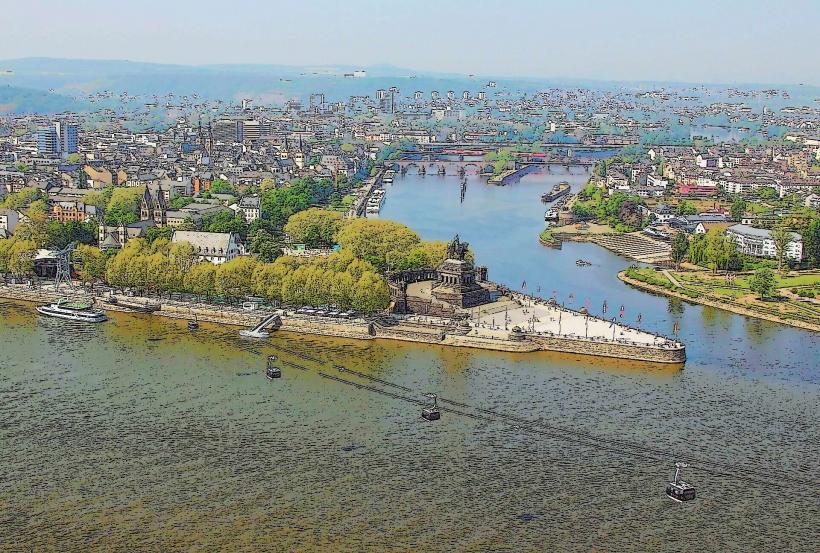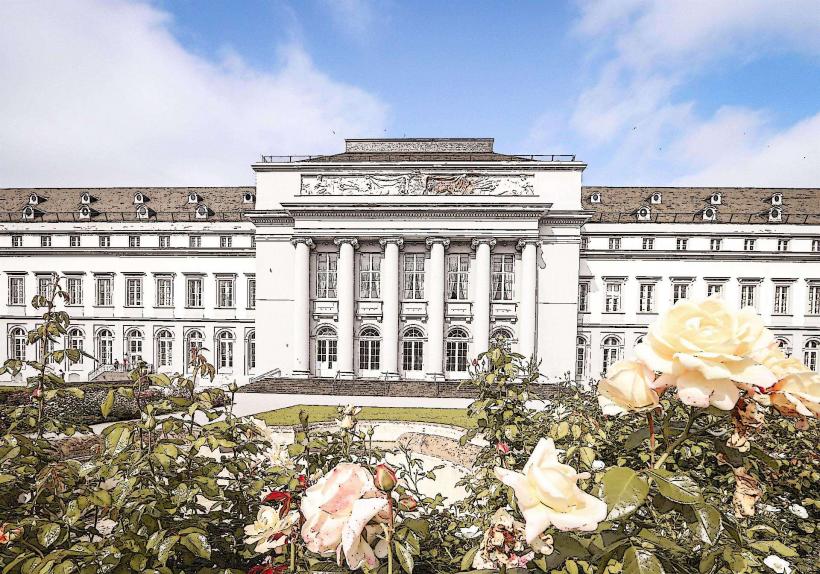Information
Landmark: Ehrenbreitstein FortressCity: Koblenz
Country: Germany
Continent: Europe
Ehrenbreitstein Fortress (Festung Ehrenbreitstein) is a historic and imposing fortress located in Koblenz, Germany, on the eastern bank of the Rhine River. It stands atop a hill with spectacular views over the river and the city of Koblenz, including the confluence of the Rhine and Moselle rivers, a place known as Deutsches Eck. The fortress is one of the largest and best-preserved hilltop fortresses in Europe, with a rich history spanning centuries, from its origins in the medieval era to its role in the modern era.
History and Origins
Medieval Beginnings: The site of Ehrenbreitstein Fortress has been strategically important since Roman times, serving as a lookout point and defensive structure. The name "Ehrenbreitstein" is believed to come from the Old High German words "Ehren" (honor) and "Breitstein" (broad stone), likely referring to the broad, fortified rock where the fortress was built.
Early Development: The first fortifications on the site date back to at least the 10th century, when the area was used as a watchtower and military outpost by the archbishops of Trier. It was later expanded and fortified by the electors of Trier during the 14th century, and it gradually became a critical part of the defensive system for the region.
17th and 18th Century Expansion: The fortress took on its current form during the 17th and 18th centuries, particularly when it was fortified by the Prussian military in the 19th century. Its position made it a key part of Germany's defense network against French incursions. The Prussians, under Frederick the Great, modernized and strengthened the fortress, making it one of the strongest fortresses in Europe at the time.
Prussian and French Conflicts: Throughout the Napoleonic Wars, the fortress was a focal point of conflict. It was besieged by the French in 1799 but was never captured. After the defeat of Napoleon, the fortress continued to serve as a symbol of Prussian power. Its military significance declined in the late 19th century with the rise of modern artillery, and it was eventually decommissioned as a military stronghold.
20th Century and World War II: During World War II, Ehrenbreitstein Fortress was used by the Germans as a military facility, but it suffered little damage during the war. After the war, the fortress became a popular tourist attraction and a historical monument to Koblenz’s military past.
Architecture and Features
Strategic Location: The fortress sits atop a mountain ridge about 118 meters (387 feet) above the Rhine River, offering panoramic views of Koblenz, the surrounding countryside, and the confluence of the Rhine and Moselle rivers. Its location allowed it to control access to the Rhine Valley, an important trade and military route through Europe.
Fortress Layout: The fortress is a complex of structures, including walls, towers, bastions, and gates. The fortress is divided into different sections, each with a distinct purpose. The main areas of the fortress include:
Main Fortress Complex: The central core of the fortress, with its massive walls and defensive gates, is surrounded by a series of outer ramparts and moats. The layout follows the traditional star-shaped design typical of 18th-century fortifications, with outer and inner defensive rings.
Bastions and Defensive Walls: The fortress has multiple bastions, which are projections from the walls that provided protection against attackers. These bastions are equipped with gun emplacements and fortifications designed to withstand artillery bombardments.
Dungeons and Storerooms: Beneath the fortress are several underground chambers, including dungeons and storerooms, which were used to house soldiers and supplies during times of war.
Military Buildings: In addition to the defensive structures, the fortress also contains a number of military buildings, such as barracks, officers' quarters, and stables, which were used to house the troops stationed there.
Fortress Walls and Gates: The fortress is surrounded by high stone walls, with an imposing main gate and several smaller entry points. The entrance is protected by a drawbridge and moat, a typical feature of medieval fortifications.
Ehrenbreitstein Fortress Today
Museum and Cultural Center: Today, Ehrenbreitstein Fortress is a major tourist attraction and a museum that showcases the history of the fortress, the city of Koblenz, and the region’s military heritage. The museum features a variety of exhibits, including historical displays, military artifacts, and interactive exhibits about the fortress’s role in the history of Germany. The fortress also hosts cultural events, including concerts, theatrical performances, and festivals.
UNESCO World Heritage: The Upper Middle Rhine Valley, which includes Ehrenbreitstein Fortress, is part of the UNESCO World Heritage Site designation for its cultural and natural significance. The area is recognized for its stunning landscapes, historic castles, and the strategic importance of sites like Ehrenbreitstein.
Koblenz Cable Car: One of the most popular ways to access the fortress today is via the Koblenz Cable Car. The cable car connects the fortress to the Deutsches Eck (German Corner), crossing the Rhine River with spectacular views of the city and the rivers. The ride offers an incredible perspective of both the fortress and the surrounding region.
Tourist Attractions and Views: The fortress grounds offer beautiful views of Koblenz, the Rhine Valley, and the Deutsches Eck. Visitors can walk around the fortress, explore the bastions, and enjoy the views from the top of the mountain. The surrounding parkland also provides a peaceful setting for picnics and relaxation.
Events and Exhibitions: The fortress regularly hosts special events and exhibitions that focus on a range of topics, from military history to contemporary art. It also features seasonal events, such as Christmas markets and fireworks displays.
Conclusion
Ehrenbreitstein Fortress is an impressive symbol of Koblenz's military past and a testament to the strategic importance of the region throughout history. Its stunning location atop a hill overlooking the confluence of the Rhine and Moselle rivers, along with its rich architectural and military heritage, make it a must-visit destination for those interested in history, architecture, and German heritage. Today, the fortress serves as both a historical monument and a modern cultural venue, attracting tourists and visitors from around the world. Whether you’re exploring its ancient walls, enjoying the views, or learning about its past, Ehrenbreitstein Fortress offers a fascinating glimpse into the history of one of Germany’s most important military sites.



